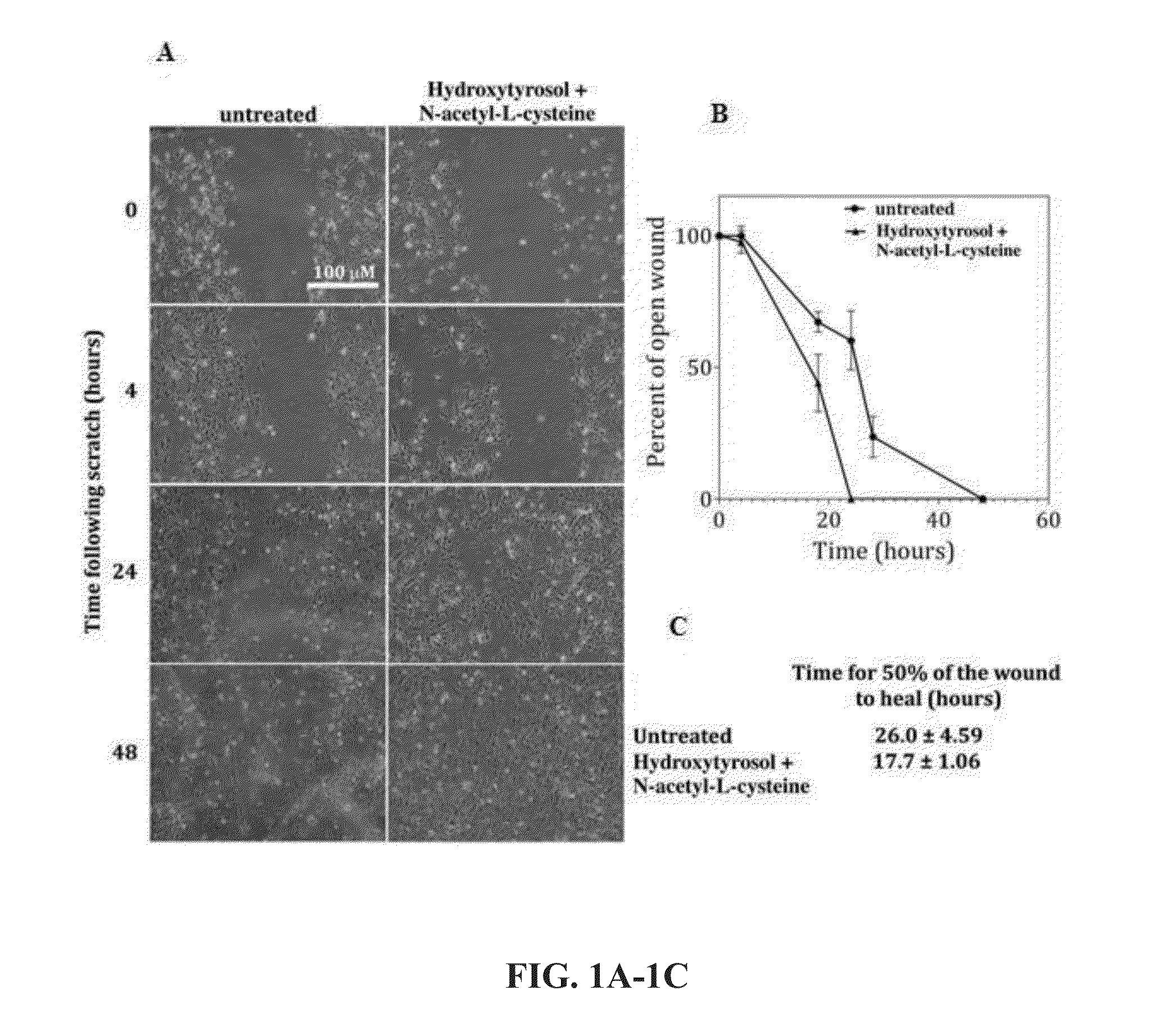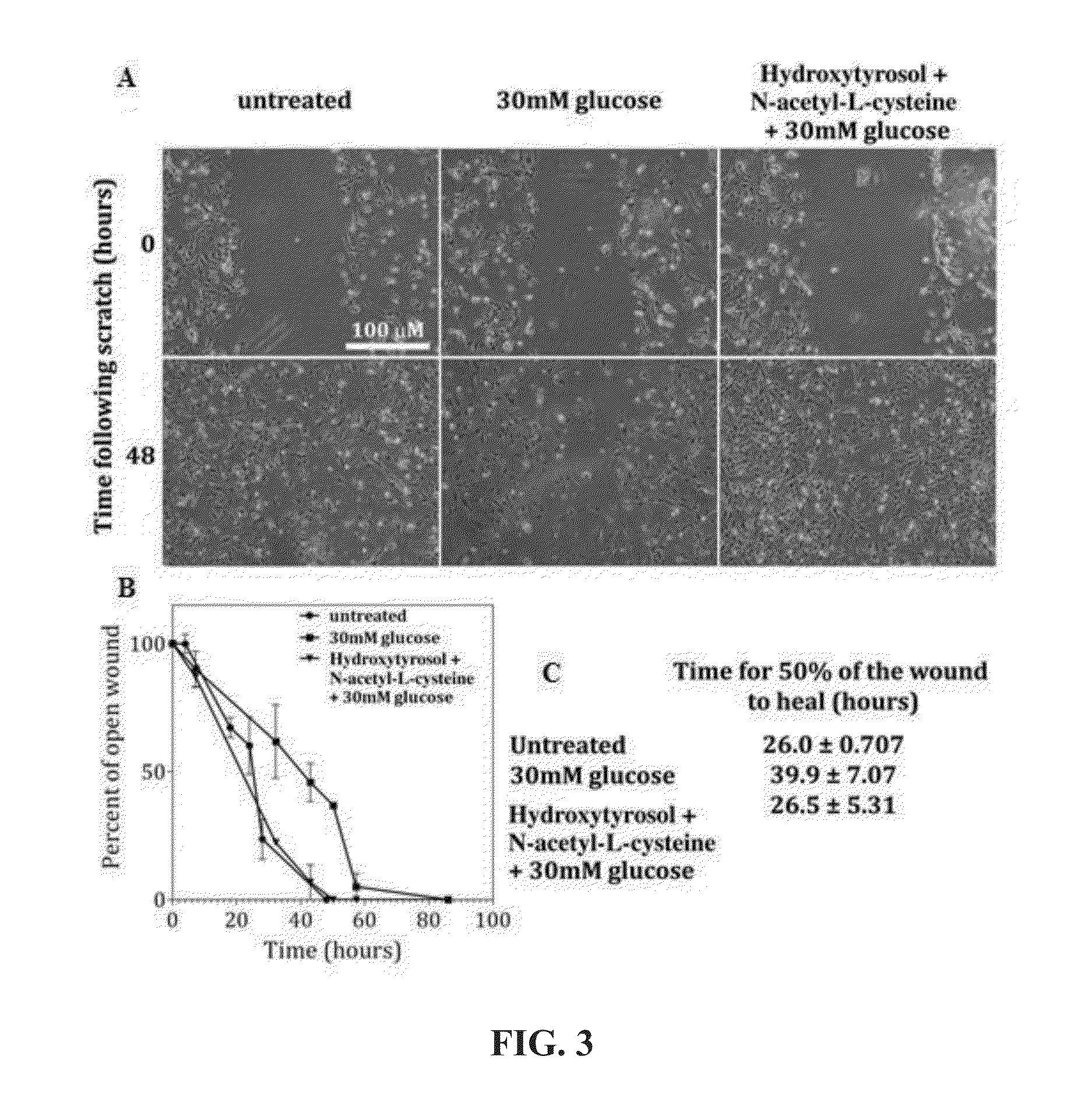Methods for improved wound closure employing olivamine and human umbilical vein endothelial cells
a technology of human umbilical vein endothelial cells and olivamine, which is applied in the field of compositions and methods for reversing damage to skin cells, can solve the problems of chronic non-healing wounds, chronic wounds that are particularly difficult to treat, and are susceptible to interruption or failure of wound healing process, so as to improve wound healing, enhance wound repair, and reduce the required time for healing a wound
- Summary
- Abstract
- Description
- Claims
- Application Information
AI Technical Summary
Benefits of technology
Problems solved by technology
Method used
Image
Examples
example 1
[0120]Original wound healing data evaluated the use of hydroxytyrosol and N-acetyl-L-cysteine for endothelial cell survival by 50%, and that in the presence of glucose, normal healing rates could be maintained by the combination. FIGS. 1-3 and Table 1 show the combination of hydroxytyrosol and N-acetyl-L-cysteine produced a synergistic effect on the time and extent of wound healing, both in the absence of glucose, and in the presence of glucose. The time for half of a wound to heal was shorter when both hydroxytyrosol and N-acetyl-cysteine were present than the additive effect of the compounds; N-acetyl-cysteine by itself increased the time to 50% healing compared to untreated. This is extremely significant and unexpected, primarily in light of the Warburg Effect, whereby high glucose levels impair wound healing.
[0121]
TABLE 1Time for 50% woundTreatmentto heal (hours)SDUntreated26.010.71Present Art17.751.06Hydroxytyrosol19.251.84Oleuropein25.622.17N-acetylcysteine28.871.95
[0122]As sh...
example 2
[0126]Additional wound studies were conducted using umbilical cord stem cells in addition to the use of hydroxytyrosol compositions and commercially-available Olivamine® compositions (20 μM hydroxytyrosol, 80 μM oleuropein, 2 mM N-acetylcysteine, 50 μM L-proline, 2 mM glycine and 100 μM taurine). These were evaluated with human umbilical vein endothelial cells (HUVEC) to assess impact on cell migration and wound healing.
[0127]HUVEC cells. Human umbilical vein endothelial cells are derived from the endothelium of veins from the umbilical cord (HUVEC primary cells purchased from Lonza). HUVECs have been widely used as a model system for the study of the regulation of endothelial cell function and the role of the endothelium in response of the blood vessel wall to stretch, shear forces and the development of atherosclerotic plaques and angiogenesis. For the following study, HUVECs are a primary endothelial cell line as a model system for the function and pathology of endothelial cells....
example 3
[0134]The precise ranges of each of the components utilized within the hydroxytyrosol and oleuropein-containing compositions were evaluated (six ingredients in relation to one another). FIGS. 9A-F illustrate the tested effects of the individual components of the claimed compositions on the growth of a vascularized endothelial cell line (e.g. cells of the stomach lining). Scientific analysis was carried out using a cell culture assay to determine relative cell viability for each ingredient. Four initial concentrations were selected for initial concentrations (see Table 3) with a negative control. Individually the ingredients showed little (see 9B and 9C) to moderate (see 9A, 9D, 9E, 9F) impact on cellular growth.
[0135]
TABLE 3Initial Concentrations TestedCompoundHydroxytyrosol (μM)052050Oleuropein (hydroxytyrosol 25%01050200standardized) (μM)N-acetyl-cysteine (mM)00.2512L-Proline (μM)02050100Glycine (mM)00.525L-Taurine (μM)050100200
[0136]To calculate the needed ratios for the claimed ...
PUM
| Property | Measurement | Unit |
|---|---|---|
| time | aaaaa | aaaaa |
| time | aaaaa | aaaaa |
| time | aaaaa | aaaaa |
Abstract
Description
Claims
Application Information
 Login to View More
Login to View More - R&D
- Intellectual Property
- Life Sciences
- Materials
- Tech Scout
- Unparalleled Data Quality
- Higher Quality Content
- 60% Fewer Hallucinations
Browse by: Latest US Patents, China's latest patents, Technical Efficacy Thesaurus, Application Domain, Technology Topic, Popular Technical Reports.
© 2025 PatSnap. All rights reserved.Legal|Privacy policy|Modern Slavery Act Transparency Statement|Sitemap|About US| Contact US: help@patsnap.com



